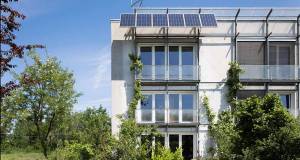
- Blogs
- Posted
Do Ireland’s energy efficiency regulations penalise energy efficiency?
What’s not to like about building regulations that demand 60% energy savings compared to boom time standards, and mandate the use of renewable energy? Glitches in the guidance documents, that’s what – glitches that unwittingly disincentivise energy efficiency best practice and risk causing building damage and compromising occupant health.
In broad terms, Part L of the Irish building regulations for dwellings represents potentially great progress for low energy building. I might be expected to say that, given that I chaired a Green Party committee on buildings that advised then minister for the environment John Gormley on matters including these regulations from 2007 to 2011 – although the final regulation was eventually signed off by Gormley’s successor, Phil Hogan – and given that the catalyst for the new regulations was local authority energy efficiency standards I worked on with Green Party councillors in Fingal, Dun Laoghaire Rathdown, Wicklow and Dublin City Council from 2005 to 2007. But there are problems in the detail in the guidance on how to achieve compliance, and they risk forcing people to make buildings less energy efficient, more polluting, and pose threats to occupant health and structural integrity.
Part L sets energy performance requirements for buildings, and as the name suggests the associated technical guidance document (TGD L 2011) provides technical guidance on how to comply. To be clear: in Ireland's common law system if your building is built in accordance with the stipulations outlined in TGD L 2011 this is regarded as prima facie evidence of compliance. However alternative methods of compliance to those outlined in the TGDs are permitted. It must therefore be a matter of proving that an alternative method complies with the requirements of Part L itself. This is bound to be open to interpretation, but given the wealth of theoretical and as-built evidence of its efficacy it would be absurd to suggest that homes built to the passive house standard cannot prove an acceptable – or even preferable – alternative to TGD L, albeit with a few add-ons to meet specific requirements of Part L itself.
The extracts of Part L that relate to new homes:
L1 A building shall be designed and constructed so as to ensure that the energy performance of the building is such as to limit the amount of energy required for the operation of the building and the amount of carbon dioxide (CO2) emissions associated with this energy use insofar as is reasonably practicable.
L3 For new dwellings, the requirements of L1 shall be met by: -
(a) providing that the energy performance of the dwelling is such as to limit the calculated primary energy consumption and related carbon dioxide (CO2) emissions insofar as is
reasonably practicable, when both energy consumption and carbon dioxide (CO2) emissions are calculated using the Dwelling Energy Assessment Procedure (DEAP) published by Sustainable Energy Authority of Ireland;
(b) providing that, for new dwellings, a reasonable proportion of the energy consumption to meet the energy performance of a dwelling is provided by renewable energy
sources;
(c) limiting heat loss and, where appropriate, availing of heat gain through the fabric of the building;
(d) providing and commissioning energy efficient space and water heating systems with efficient heat sources and effective controls;
(e) providing that all oil and gas fired boilers shall meet a minimum seasonal efficiency of 90%;
(f) providing to the dwelling owner sufficient information about the building, the fixed building services and their maintenance requirements so that the building can be
operated in such a manner as to use no more fuel and energy than is reasonable.
So to be clear, to satisfy the regulation we need to limit the primary energy use and CO2 emissions associated with the energy performance of the building insofar as is reasonably practicable, as calculated using Deap. (As an aside, Deap only counts heating, hot water, lighting, ventilation and cooling — any plug in devices are disregarded, therefore ignoring a substantial amount of primary energy and carbon emissions).
Then we need to generate a reasonable proportion of energy consumed to meet the energy performance from renewable energy sources. The use of the word proportion surely implies a fraction rather than a static numerical target. Does the proposed minimum compliant value in TGD L of 10 kWh/m2/yr therefore contradict the regulation? As per several examples published by Passive House Plus and its predecessor Construct Ireland, very low energy buildings are at a disadvantage in hitting this target compared to buildings which aim for more modest (but still TGD L compliant) energy efficiency levels, even though they may provide a similar or greater proportion of their smaller energy demand from renewables.
The TGD creates a problem by setting the minimum compliance limits to satisfy L3(A) as 60% energy and carbon reductions relative to 2005 standards. To paraphrase Part L itself, suppose a developer finds it "reasonably practicable" to go further – say to a 70% energy and carbon reduction. By reducing the primary energy demand, they will then have a tougher time meeting the 10 kWh/m2/yr renewables target as stipulated in TGD L. Quite simply they won't have enough energy demand to easily meet this target. If the building’s energy efficiency is weakened to a 60% rather than 70% reduction in some instances this will increase the energy demand sufficiently to satisfy the 10 kWh/m2/yr renewables contribution, but as the building has been made less energy efficient than the developer found “reasonably practicable” does this not mean the building fails to satisfy Part L 3(a)?
It's true that TGD L actually gives two options – 10 kWh of thermal renewable energy or 4 kWh of microgen – but this is a distraction in the context of this argument. We should remember first and foremost that people should be trying to produce the best building for the occupants' needs rather than just to comply with building regulations. There is also an argument that energy efficiency of the building fabric should always take precedence over clean energy generation. Fabric measures lock in energy savings for considerably longer than mechanical systems, due to their substantially longer lifespan – of the order of 50+ years for many fabric measures, compared to circa 20 years for mechanical and electrical measures. This is not to doubt the importance of low carbon, efficient heating and electrical systems. But technology doesn’t absolve us of the need to build genuinely energy efficient, robust building fabric.
Example: passive house plus heat pump
Look at the scenario of someone building a passive house on a tight budget in an area that's off the gas grid. Suppose their preferred option from a heating and domestic hot water point of view is a heat pump. But because they've built a passive house and therefore reduced their space heating load, and because of the penalties applied to heat pumps respectively by TGD L and Deap, they can only count a fraction of the energy generated by the heat pump as renewable. Suppose this is giving them 8 kWh/m2/yr of renewable energy, and that their total primary energy demand is 60 kWh/m2/yr. So 13.3% of their energy demand is coming from renewables, but they're failing to hit the 10 kWh/m2/yr target in TGD L. Suppose they decided to reduce the quality of the building fabric and increase their energy demand to say 75 kWh/m2/yr. Deap will now show that that same heat pump is generating more renewable heat, just because the building has a bigger demand. So it might now have hit the 10 kWh/m2/yr target. But this is exactly the same percentage or proportion of 13.3%. So the building now satisfies TGD L, but the total primary energy demand, associated carbon emissions and running costs have increased. Also, depending on what measures were taken to increase the energy demand – such as making the building less airtight, failing to address cold bridges, and/or removing a mechanical ventilation system – the building may be more prone to structural damage and poor indoor air quality.
But suppose the developer was still resolved to build a passive house. From a compliance point of view, one might say they could simply install a solar photovoltaic array to hit the 4 kWh renewable electricity target, and install an oil boiler. This may tick a box in TGD L, but may result in needlessly high running costs. True, as a passive house the space heating costs are bound to be low – although they'll still be needlessly more expensive for oil or LPG than many other fuel sources – but there's also the matter of the domestic hot water supply. The heat pump may have been able to provide this at a considerably lower cost than oil.
Bearing in mind their tight budget, the developer now has the following options:
• build the passive house with an oil boiler instead of the preferred option of a heat pump, with a PV array to meet the renewables target. Although the building will have a small space heating demand, this leaves the occupant with a high fuel cost (and the prospect of exponential increases) per kWh for space heating and hot water, and a PV array for which they’ll receive little remuneration if they export to the grid (9c per kilowatt, and only if they’re Electric Ireland customers, and with no guarantee that even this tariff will persist for long);
• forgo the passive house standard, say by making the building less airtight, with less attention to continuous insulation, removing the designed ventilation system – and install the heat pump. Ensure that the building still hits the EPC and CPC targets in TGD L, albeit only just. This may now meet the renewables contribution target, but the building’s overall energy demand and running costs will have increased, and although it ticks every box in TGD L, it arguably fails to comply with Part L 3(A), in that it’s been built to have higher energy consumption and more carbon emissions than the developer found “reasonably practicable” to build. Its kWh/m2/yr consumption has also increased – conceivably from an A2 to an A3 BER, reducing the asset value by circa 5% too (Hyland, R Lyons & S Lyons, 2012);
• build the passive house with heat pump, and don’t tick the renewables contribution box in TGD L. The building will this have low space heating demand, increased comfort and lowest fuel costs per kWh of heat. Although it could be argued that it satisfies the “reasonable proportion” of energy from renewables required by Part L, its failure to meet the prescribed levels in TGD L could leave the developer or assigned certifier running into problems with building control – and conceivably with the banks where a mortgage is involved.
Problems with Part L, and the passive house solution
Low energy buildings perform differently from thermally inefficient buildings. Efforts to reduce heat loss from buildings also change how vapour moves through a building, potentially leading to increased risk of interstitial and surface condensation, with the associated threats to indoor air quality and the building structure. As the founder of the Passive House Institute, Prof Dr Wolfgang Feist explains, the Passive House Institute set stringent airtightness targets for passive house – translating to roughly ten times tighter than the minimum under Irish Part L – to prevent interstitial condensation from occurring. In this regard the key elements of passive house – a continuous thermal insulation layer, exacting airtightness and a mechanical ventilation system – were chosen to prevent surface and interstitial condensation from occurring. It’s also required to keep opaque internal surface temperatures above 16C and windows above 13.5C (assuming -5C ambient temperature), in order to maintain comfort and stop a dew point from being reached inside the building.
TGD L on the other hand permits a very poor airtightness value of 7m3/hr/m2 at 50 Pa, permits the use of thermal bridging details from the Acceptable Construction Details, some of which are considered sub-standard by at least two of the committee members who helped to prepare them, and permits the use of “natural” ventilation systems and intermittent fans – a ventilation strategy whose efficacy is unsupported by evidence in low energy buildings or otherwise, as Kate de Selincourt revealed in forensic detail in issue six of Passive House Plus. There is therefore a very real prospect that a building designed and built in accordance with TGD L could compromise occupant health via poor indoor air quality and suffer from structural damage – precisely because of flaws in the guidance.
Conclusion
At the very least the department should permit and even recommend certified passive houses – where they can be shown to satisfy the requirements of Part L, but irrespective of whether they meet the targets set out in TGD L – as an alternative method of compliance. The reason for stipulating that the passive houses should be certified is because of the quality assurances that certification brings – including independent assessment of the detailed design. Given that the first passive houses were built over 20 years ago (and 10 years ago in Ireland) there is a wealth of evidence – including actual data on energy consumption, indoor air quality, etc – to support the efficacy of this approach. Such evidence simply doesn’t exist in the case of TGD L.
Related items
-
 Big picture - New Zealand rural passive home
Big picture - New Zealand rural passive home -
 Podcast: what we've learned from 20 years in green building mags
Podcast: what we've learned from 20 years in green building mags -
 45,000 more Irish homes face radon risk, new maps reveal
45,000 more Irish homes face radon risk, new maps reveal -
 Passive house 30 years on: qualified success or brilliant failure?
Passive house 30 years on: qualified success or brilliant failure? -
 Above the curve - Limerick passive house showcases precision timber engineering
Above the curve - Limerick passive house showcases precision timber engineering -
 International passive house conference kicks off
International passive house conference kicks off

